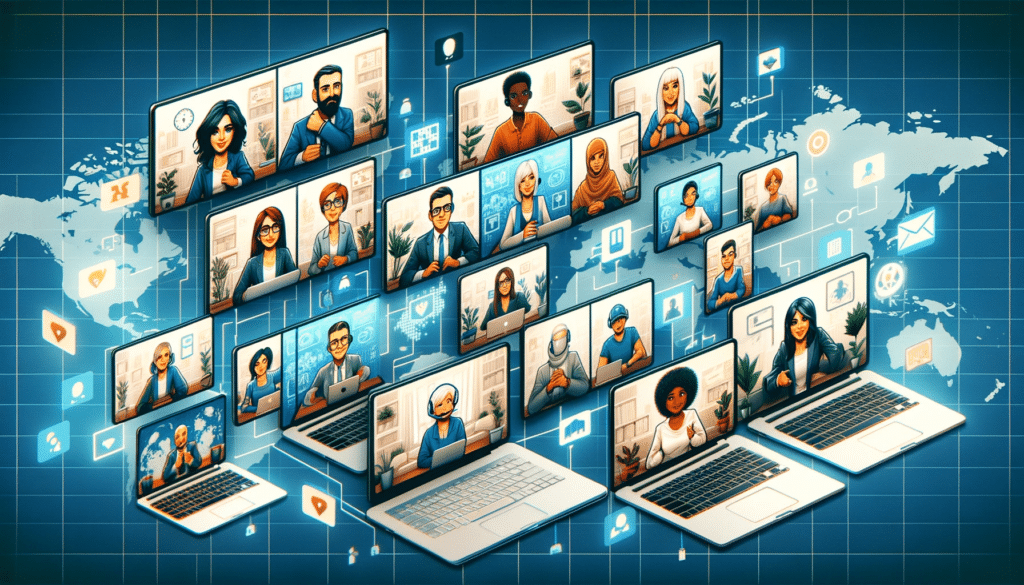Fostering Inclusivity in a Global Workforce through Virtual Team Building
In an era where the concept of a global workforce is increasingly becoming the norm, the challenge facing organisations is clear: how do you foster a sense of unity and inclusivity amongst a team that spans continents, cultures, and time zones? The answer lies in embracing the power of virtual team building activities. This blog post delves into the pivotal role these activities play in bridging the gaps in a diverse workforce, ensuring a more inclusive and connected organisational environment.
The Rise of the Global Workforce and the Challenge of Inclusivity
Understanding the Dynamics of a Global Team
The global workforce is a rich tapestry of diverse cultures, languages, and working styles. With the advent of technology and remote working models, businesses, both large and small, are increasingly hiring talent from across the globe. This diversity, while a significant asset, also brings forth challenges in maintaining a cohesive and inclusive team dynamic.
Inclusivity Challenges in a Global Setting
Inclusivity in a global workforce goes beyond just bringing together individuals from different geographic locations. It involves creating an environment where every team member, irrespective of their cultural or geographical background, feels valued and integral to the team. The challenge for business leaders and HR professionals is to foster this sense of belonging and ensure that no one feels isolated or misunderstood because of their unique perspectives or working styles.
Virtual Team Building – A Gateway to Greater Inclusivity
Defining Virtual Team Building
Virtual team building involves a range of activities and exercises conducted remotely, aimed at strengthening bonds and improving collaboration among team members who may not share a physical workspace. In the context of global teams, these activities are not just a luxury but a necessity for fostering inclusivity and team cohesion.
The Power of Virtual Team Building Activities
By engaging in virtual team building activities, teams can overcome the barriers of distance and cultural differences. These activities are designed to enhance communication, build trust, and create a sense of camaraderie amongst team members. From virtual escape rooms to virtual cookery events, these activities offer a platform for team members to learn about each other’s cultures, working styles, and personalities in a fun and engaging environment.
Benefits of Embracing Virtual Team Building
The impact of virtual team building on inclusivity is profound. Teams that regularly participate in these activities report higher levels of engagement, better communication, and a stronger sense of belonging. For a global workforce, this translates into improved collaboration, increased productivity, and a more harmonious work environment.
Implementing Virtual Team Building for Maximum Impact
Strategic Implementation of Virtual Team Building
The effectiveness of virtual team building activities hinges on strategic implementation. For business owners and HR professionals, it’s vital to align these activities with the broader objectives of the organisation. This means understanding the unique dynamics of your global team and selecting activities that cater to diverse needs while promoting inclusivity.
Engaging a Diverse Team in Virtual Activities
Engagement is key in virtual team building. Tailoring activities to be inclusive and accessible for all team members, regardless of their location, language, or cultural background, is crucial. This might involve varying the types of activities, considering different time zones, and using technology that is accessible to everyone. Encouraging open communication and feedback can also help in fine-tuning these activities to better suit team needs.
Measuring the Success of Your Virtual Team Building Efforts
Key Metrics to Assess Effectiveness
Measuring the impact of virtual team building activities is essential for continuous improvement. Key metrics might include employee engagement levels, feedback from team members, and productivity indicators. Regular surveys and feedback sessions can provide insights into how these activities are affecting team dynamics and morale.
Continuous Improvement and Adaptation
A one-size-fits-all approach doesn’t work in virtual team building. Continuous assessment and adaptation are crucial for long-term success. This might involve regularly updating activities, incorporating new technologies, or adjusting strategies based on team feedback. The goal is to create a dynamic and responsive approach that grows with your team.
Leveraging Tools and Resources
To aid in these efforts, several tools and resources are available for virtual team building. From online communication platforms to virtual event facilitators, utilising these resources can enhance the quality and impact of your team building initiatives. Researching and investing in the right tools can significantly contribute to the success of your virtual team inclusivity efforts.
Conclusion: Embracing a Future of Inclusive Virtual Team Building
In the rapidly evolving landscape of global business, the need for inclusivity within teams has never been more pressing. As we have explored, virtual team building activities play a pivotal role in bridging the cultural and geographical gaps that can exist in a diverse workforce. For organisations of all sizes, these activities are not just a means to an end but a cornerstone of building a truly cohesive and inclusive global team.
The journey towards creating an inclusive environment through virtual team building is ongoing and dynamic. It requires a thoughtful approach, one that considers the unique makeup of your global team and adapts to their evolving needs. By strategically implementing these activities, engaging diverse team members, continuously measuring their impact, and adapting as necessary, organisations can foster a culture of inclusivity and collaboration.
The future of work is undeniably global, and the organisations that will thrive are those that embrace virtual team inclusivity. As you embark on or continue this journey, remember that the goal is not just to bring people together virtually but to create a space where every team member feels valued, understood, and connected, regardless of their location.
In conclusion, the power of virtual team building in creating an inclusive global workforce is clear. It is an investment in your team’s cohesion, productivity, and overall satisfaction. By embracing these practices, you are not only bridging gaps but also building a stronger, more unified future for your organisation.


